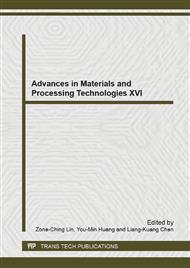p.239
p.245
p.253
p.260
p.266
p.274
p.283
p.291
p.299
Stiffness Improvement of Stamping Die by Means of Topology Optimization
Abstract:
Stiffness improvement of stamping die without weight increase 780MPa grade high strength steel sheet was achieved by using Finite Element (FE) simulation combined with topology optimization. In the first step of the procedure, FE simulation of a stamping process was conducted in order to evaluate the contact force on a die surface at the end of stamping. Subsequently, topology optimization was carried out subject to the prescribed weight constraint, in which the stiffest die structure for the given force and displacement boundary conditions was obtained. Maximum displacements during stamping between thus optimized die and the one designed by the experienced engineer were compared. It was found that the optimized die showed less deformation than the other even if the total weights of both dies were almost the same.
Info:
Periodical:
Pages:
266-273
Citation:
Online since:
May 2014
Price:
Сopyright:
© 2014 Trans Tech Publications Ltd. All Rights Reserved
Share:
Citation:


